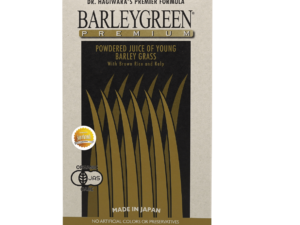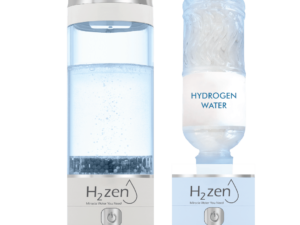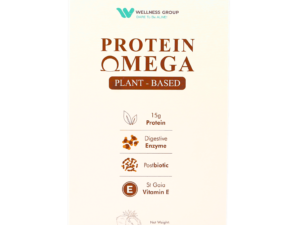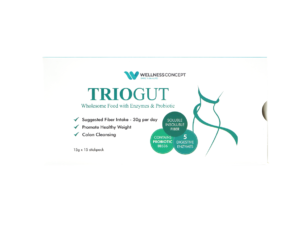Hydrogen water generator for functional medicine – Wellness Group
Surprising fact: recent small trials report measurable changes in oxidative stress markers after just weeks of daily intake, hinting at clinical reach that surprises many clinicians.
Wellness Group introduces an evidence-aware guide that explains what this approach is and why some clinics in Malaysia are exploring it. The piece frames early research signals—antioxidant, anti-inflammatory, and recovery effects—while stressing that larger trials are needed.
The article outlines practical steps to integrate a device into clinical flows and home routines. It covers device choices, dosing targets, maintenance, and how teams track outcomes alongside nutrition, sleep, and stress management.
Clinicians and consumers get clear limits and realistic expectations. Contact options are simple: WhatsApp +60123822655 during business hours (Mon–Fri 9:30 am–6:30 pm; Sat–Sun 10 am–5 pm) for Malaysia-based support and consultations.
Key Takeaways
- Early studies show promising signals but are not yet definitive.
- Integration works best when tied to clear clinical workflows and outcome tracking.
- Wellness Group can advise on selection, installation, and upkeep.
- Safety, dosing, and device tech are covered later in the article.
- Expect a balanced review combining peer-reviewed research and practical guidance.
Why hydrogen water matters in functional medicine today
Interest in dissolved H2 stems from its easy use and low overhead. Clinics can deliver it via portable units, tablets, or electrolyzed bottles. These options suit busy practices and at-home plans.
Practical appeal: clinicians favor approaches that are low-risk, easy to add to daily routines, and that pair with nutrition and sleep strategies. Early studies have explored cardiometabolic markers, exercise outcomes, and oxidative stress, showing promising but modest signals.
Because sample sizes are often small, adoption should be cautious. Many teams implement short monitored trials rather than broad rollouts. Practitioners track baseline oxidative stress and inflammation markers to see if changes occur.
- Supports root-cause programs by targeting oxidative stress and inflammation.
- Improves patient engagement through a simple daily habit.
- Generators and tablets reduce single-use waste and ease clinic workflows.
For Malaysia-based clinics, Wellness Group offers device selection and training. Contact WhatsApp +60123822655 during business hours for local guidance and setup support.
Understanding molecular hydrogen, hydrogen gas, and hydrogen-rich water
A quick primer follows on how H2 goes from a gas into a drinkable form and what that means biologically.
From H2 gas to hydrogen water: how infusion works
Molecular hydrogen (H2) is the smallest, neutral gas that diffuses across membranes and can dissolve into drinking water up to about 1.6 ppm at room temperature and normal pressure.
Clinics and consumers use three common infusion methods: pressurized dissolution, electrolysis-based generation, and magnesium-based reactions that release H2 into water. Timing matters—dissolved H2 declines after generation, so drink soon after making it.
Key terms: reactive oxygen species, oxidative stress, and antioxidant activity
Reactive oxygen species include highly reactive forms like hydroxyl radicals (-OH) and peroxynitrite (ONOO−). When these oxygen species overwhelm defenses, oxidative stress and cellular damage follow.
Ohsawa et al. helped shift thinking by showing H2 can selectively scavenge the most damaging radicals while sparing beneficial signaling species. That selective antioxidant action is central to clinical explanations.
“H2 selectively reduces the most reactive radicals, not general cellular oxygen signaling.”
- Aluminum containers retain dissolved H2 longer than glass or plastic, preserving concentration.
- Electrolyzed hydrogen water (EHW) may show extra ROS scavenging in vitro, possibly due to platinum particles from electrodes.
- Clinicians should explain simple points: what H2 is, how it is made, why timing and container matter, and realistic expectations.
Mechanisms: how molecular hydrogen may influence oxidative stress and inflammation
Preclinical work suggests molecular hydrogen acts selectively at the molecular level. It appears to hit the most aggressive oxygen-derived radicals while leaving normal cell signaling intact.
Selective scavenging of hydroxyl radicals and peroxynitrite
Hydrogen targets highly reactive species such as hydroxyl radicals and peroxynitrite. This selective activity can reduce collateral oxidative damage without broadly suppressing redox signaling.
Nrf2, NF-κB, and redox signaling pathways
Models report modulation of key transcription factors. Activation of Nrf2 raises antioxidant defenses like HO-1, while dampening NF-κB lowers pro‑inflammatory cytokines.
Anti-apoptotic and cytoprotective effects
Across cells and tissues, studies note reduced apoptosis and improved cell survival. These cytoprotective signals may underlie reported functional improvements in small studies.
Hormetic-like responses and unresolved mechanisms
Some data suggest a hormetic effect: mild modulation triggers adaptive resilience. Still, precise pathways remain only partly resolved, and multiple concurrent routes likely contribute.
- Key role: selective reactivity distinguishes this approach from blunt antioxidants.
- Mechanistic insight helps guide dosing, timing, and device choice later in this article.
- Human trials linking clinical endpoints with mechanistic biomarkers are needed to confirm translational value.
Hydrogen water generator technologies used in clinics and at home
A clinic must balance convenience, concentration stability, and total cost when choosing a system. Small clinics and households prefer options that are easy to maintain and give predictable effects.
Electrolyzed systems versus dissolved solutions
Electrolyzed hydrogen water (EHW) forms at the cathode and often runs alkaline (pH 9–10). In vitro reports show EHW can keep greater ROS scavenging than plain dissolved solutions at equal dissolved H2, with about 60% activity sometimes remaining after dissolved gas falls.
Device types: units, bottles, and tablets
Electrolysis units use electrodes (often platinum‑coated), membranes, and power modules. Portable bottles are simple and travel‑friendly. Tablet systems release gas by reaction and suit clinics that need low upkeep.
Concentration, containers, and practical notes
Max solubility is ~1.6 ppm; aluminum bottles retain dissolved molecules best. Timing from generation to drinking matters: shorter delay preserves concentration and consistency across patients.
- Maintenance: regular electrode cleaning and third‑party testing keep performance steady.
- Pt electrodes: trace Pt nanoparticles may boost reductive activity but require quality certification.
- Wellness Group helps Malaysian clinics choose EHW‑capable units, portable bottles, or tablet systems—contact WhatsApp +60123822655 during business hours.
Evidence snapshot: potential health benefits and current research status
A 2024 systematic review that screened about 25–30 human trials found encouraging signals across domains but stressed the need for larger, rigorous work.
Encouraging trials, but limited scale
Human studies show small but consistent signals in select lipid markers, antioxidant capacity, endothelial proxies like RHI, and reduced subjective fatigue.
Where results are mixed
Athletic performance trials report variable outcomes. Benefits often depend on baseline fitness, dosing, and timing of intake.
“Current studies are promising yet heterogeneous; independent replication is essential.”
- Early positive areas: lipid profiles, endothelial function, fatigue relief, and some liver and mood markers.
- Key caveats: small samples, short follow-up, variable concentrations, and possible commercial bias.
- Clinical approach: use as an adjunct, monitor validated biomarkers, and collect patient-centered outcomes.
| Domain | Evidence Strength | Notes |
|---|---|---|
| Lipid & vascular | Moderate | Improvements in select lipids and RHI in several studies |
| Exercise & recovery | Mixed | Depends on protocol and baseline fitness |
| Liver & mental health | Preliminary | Early positive signals need replication |
| Overall | Cautious optimism | Larger RCTs, independent trials, and local Malaysia data are needed |
Recommendation: clinicians should view hydrogen water as a potential therapeutic adjunct, not a replacement. They should track outcomes and support regional research to build stronger, locally relevant evidence.
Hydrogen water and exercise performance: endurance, fatigue, and recovery
Emerging sports studies report short courses of dissolved H2 may change high-intensity effort and recovery. A 7‑day nano‑bubble trial showed better anaerobic output in trained cyclists versus untrained peers.
Findings on lactic acid and breathing note that pre‑workout hydrogen-rich water reduced blood lactic acid at higher intensity and improved ventilatory efficiency. These shifts suggest less acute fatigue during repeat sprints.
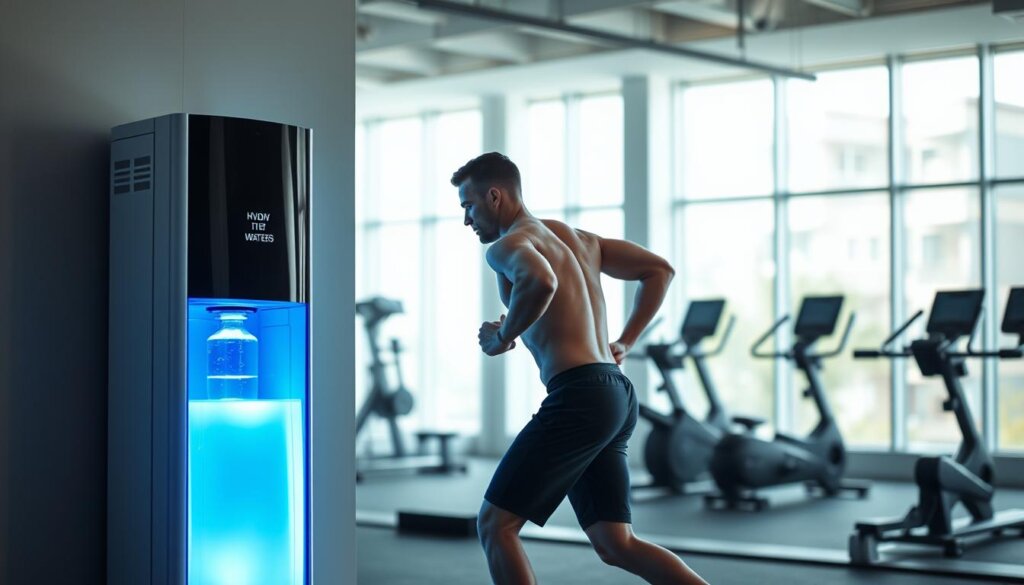
Mixed responses and practical guidance
Randomized crossover trials give mixed results: overall race time effects were unclear, with slower runners gaining ~1.3% while top performers saw slight declines.
Training status appears to shape benefits. In juvenile female soccer players, two months of hydrogen-rich water raised antioxidant capacity and altered inflammatory markers.
- Mechanism: reduced oxidative stress and moderated inflammation may support repeated-bout recovery.
- Dosing: take a dose pre‑exercise and ensure concentration is high at consumption.
- Monitoring: track time to exhaustion, RPE, lactate, heart rate, and subjective recovery.
Recommendation: trial 4–8 weeks with a standard training plan to spot responders. Wellness Group can advise Malaysian teams on safe setup and measurement. Hydrogen approaches are non‑stimulant and generally safe, but expectations should stay realistic.
Cardiometabolic applications: lipid profiles, glucose markers, and vascular function
Some short studies report improved cholesterol metrics and blood sugar control after consistent intake. Clinicians should view these results as promising but early.
Changes in LDL-C, HDL function, apoB, and triglycerides
In a 10-week trial, total cholesterol and LDL-C fell, with smokers showing larger triglyceride drops. An 8-week open-label study found an 8% rise in HDL and improved antioxidant markers.
Metabolic syndrome markers and hemoglobin A1c trends
A randomized trial in people with metabolic syndrome reported lower fasting glucose and cholesterol, better HbA1c, and reductions in waist-to-hip ratio and BMI. These shifts suggest clinical benefit when paired with lifestyle care.
Endothelial function and reactive hyperemia index improvements
Endothelial proxies improved quickly in some studies. One report documented a 25.4% RHI increase after two weeks, indicating potential short-term vascular gains.
Biomarker links: antioxidant change was notable — SOD rose ~39% and urinary TBARS dropped ~43% in a small trial. These shifts may mediate lipid and vascular outcomes by lowering oxidative stress.
- Heterogeneity: smokers sometimes benefit more on triglycerides.
- Practical counsel: consider monitored trials in patients with dyslipidemia or metabolic syndrome features.
- Baseline testing: lipids, HbA1c, inflammatory markers, and RHI where available.
Integration tip: include this approach within diet, activity, sleep, and stress plans. Choose devices that keep concentration consistent and coach patients on timing and storage to preserve levels at intake.
Liver function and gut health: hepatitis, NAFLD, and IBD signals
Early clinical and lab work highlights possible benefits on liver function and gut symptoms when patients take dissolved H2 regularly. Findings remain small but promising and deserve cautious clinical follow-up in Malaysia.
Chronic hepatitis B: In trials where participants consumed 1,200–1,800 mL/day of hydrogen-rich water, researchers noted improved liver tests, lower HBV DNA, and reduced oxidative stress markers. These shifts suggest a potential adjunct role in monitored care.
Non-alcoholic fatty liver disease (NAFLD)
Early human data show modest improvements in liver function and biomarkers with hydrogen-rich water. Results are hypothesis-generating and support larger hepatology trials rather than broad clinical adoption.
Inflammatory bowel disease models
Preclinical work with electrolyzed hydrogen water reduced colitis severity, cut pro-inflammatory cytokines, and eased abdominal pain. Mechanisms included NF-κB suppression and activation of Nrf2 antioxidant pathways.
- Mechanistic link: ROS–inflammation crosstalk appears central, with NF-κB downregulation and Nrf2-driven defenses in gut and liver tissue.
- Clinical caution: explore patients under supervised protocols and track ALT, AST, GGT, inflammatory markers, and symptom scores.
- Adjuncts: combine with dietary fiber, omega-3s, and targeted probiotics to amplify gut-directed benefits.
| Condition | Evidence | Clinical note |
|---|---|---|
| Chronic hepatitis B | Improved LFTs; lower HBV DNA | Use as adjunct in monitored trials; track viral load and enzymes |
| NAFLD | Early human signals | Require larger RCTs; pair with lifestyle care |
| IBD (preclinical) | Reduced mucosal inflammation; less pain | Pilot clinical testing needed; monitor symptom scores |
Practical tip: keep adequate dissolved gas concentration until drinking time to maximize potential effects and ensure consistency across patients. Larger controlled studies in Malaysian populations remain a priority to confirm transferability and real-world benefits.
Mental health and neurological angles: mood, anxiety, and neuroinflammation
A compact body of short-term trials has explored links between dissolved H2 intake and mood, autonomic balance, and markers of brain inflammation.
Autonomic balance and mood outcomes in short-term studies
A 4-week trial reported better mood scores, reduced anxiety, and improved autonomic nerve function after daily hydrogen water intake.
In a psychiatric study of panic disorder, adjunct intake did not beat placebo on primary clinical outcomes. Still, researchers found reductions in pro‑inflammatory cytokines (IL‑6, IL‑1β, IL‑12, TNF‑α).
Interpretation: lowered cytokines suggest a physiological effect that may support symptom domains even when symptom scales do not shift quickly.
- Neuroinflammation and oxidative stress link to mood and anxiety biology; modulating those pathways may complement psychotherapy and meds.
- Trial use is reasonable in stress‑related presentations with close monitoring and shared decision‑making.
- Track standardized scales (GAD‑7, PHQ‑9), sleep, and HRV to spot signals.
Practical tips: pair intake with exercise, sleep hygiene, and an anti‑inflammatory diet. Time doses to morning routines or before known stressors to aid adherence.
Evidence is preliminary; clinicians should use symptom journaling and short monitored trials. If neuroinflammatory pathways are moderated long term, there may be relevance to healthy aging—larger trials in Malaysia are needed to confirm.
Renal and dialysis insights: fatigue, oxidative status, and quality of life
Some pilot work shows that modified dialysis fluids can blunt oxidative spikes and improve post‑dialysis recovery.
In chronic dialysis cohorts, electrolyzed solutions and daily intake of electrolyzed hydrogen water have been linked to better renal function proxies and lower blood urea nitrogen.
During hemodialysis, adding EHW to dialysis solutions reduced oxidative stress and often cut patient fatigue during and between sessions. End‑stage renal disease reports also note improved inflammatory markers and quality of life indices.
Clinical implications and practical checks
Benefits may include less session fatigue, improved antioxidant defenses, and modest renal function signals. These outcomes align with goals to lower systemic oxidative load and raise patient well‑being.
- Collaborate with nephrology teams to test feasibility in supervised pilots.
- Prioritize device hygiene, source water quality, and maintenance in dialysis settings.
- Implement conservatively with close lab and symptom monitoring.
- Consider home support between sessions, with clear timing and storage guidance.
“Rigorous randomized trials in dialysis populations are limited; larger studies are needed.”
| Outcome | Reported Change | Clinical Note |
|---|---|---|
| Fatigue | Reduced during/between sessions | Supports adherence to rehab and therapies |
| Inflammation | Lower cytokine markers | Monitor CRP, IL‑6 trends |
| Renal function proxies | Improved BUN and related metrics | Short‑term signals; need replication |
Clinicians in Malaysia should view these signals as promising but preliminary. This article recommends small, monitored trials and cross‑team planning to protect patient safety and test real‑world value.
Oncology and immune modulation: emerging adjunctive roles
Emerging lab and small clinical reports suggest dissolved gas intake may modulate tumor biology and patient well‑being. Evidence remains preliminary but points to two practical aims: modify the tumour microenvironment and improve quality of life during treatment.
Tumor microenvironment, fibrosis, and oxidative damage considerations
Hypotheses propose that reduced oxidative damage and lower local inflammation can change stromal responses, slow fibrosis, and limit tumour growth. Models show less collagen deposition and smaller tumours when dissolved gas intake is paired with chemotherapy agents such as 5‑fluorouracil.
Immune modulation signals include shifts in cytokines and macrophage activity. These findings suggest potential synergy with immune therapies, but interactions could be complex and need careful study.
Clinical implications and safety
- Small trials and reviews report better symptom control and possible tumour shrinkage when used adjunctively.
- Quality‑of‑life gains (fatigue, appetite, pain) are a feasible near‑term goal while survival data remain scarce.
- Use only as an adjunct under oncologist supervision; never delay or replace proven therapies.
“Adjunctive strategies should prioritize patient safety, clear consent, and documented outcome tracking.”
| Area | Reported Signal | Clinical Note |
|---|---|---|
| Tumour growth | Reduced in some preclinical and small clinical reports | Promising but not definitive; larger RCTs needed |
| Fibrosis | Lower collagen and scar markers in models | May improve drug penetration; translational studies required |
| Quality of life | Improved fatigue and appetite in small studies | Reasonable near‑term clinical objective with monitoring |
| Immune signals | Modulated cytokines and macrophage profiles | May interact with immunotherapies; study with caution |
Practical guidance: ensure device quality and source purity, time intake to preserve concentration during treatment days, and track symptoms and safety labs. Clinicians in Malaysia should prioritize trials that define which cancer types and stages, if any, benefit most and always obtain informed consent.
Hydrogen water in infectious and respiratory contexts, including COVID-19
Respiratory infections often worsen when unchecked inflammation and oxidative stress damage lung tissue and raise airway resistance.
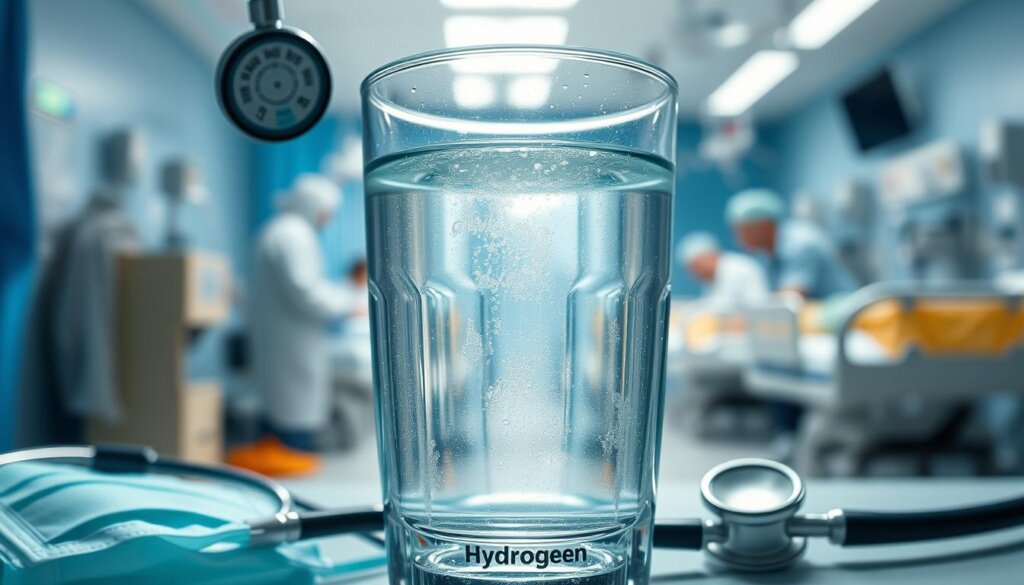
Rationale: Therapies that damp cytokine cascades and reduce oxidative stress may limit severe lung injury and speed recovery.
Clinical observations during COVID-19 reported that inhaled treatments with small neutral gas reduced cytokine signaling and eased inhalation resistance in mild to moderate cases. Parallel reports suggest hydrogen-rich water can show biological effects even after the gas clears.
- Practical note: hydrogen water is a convenient, adjunct route but evidence on infection outcomes is preliminary.
- Use it only as supportive care during recovery under clinician guidance, not as a substitute for proven treatments.
- Track safe endpoints: fatigue, HRV, sleep quality, and inflammatory markers where available.
“Larger, ethically designed trials are needed to define real benefit and risk.”
Operational points: reinforce public health measures, maintain strict device sanitation to avoid contamination, and educate patients about realistic expectations. For related clinical guidance, clinicians may review hydrogen water during pregnancy and adapt protocols sensibly.
Integrating a Hydrogen water generator for functional medicine in practice
Clinics that add a targeted intake routine typically begin with a short, monitored pilot to test feasibility and patient response.
Workflow: screening, baselines, dosing, and follow-up
Step 1: screen candidacy and set clear goals. Obtain baselines: lipid panel, HbA1c, inflammatory and oxidative markers, and RHI where available.
Step 2: set an initial dose in the study range—about 20–70 ounces daily—and stress prompt consumption after generation to preserve dissolved hydrogen. Use aluminum bottles when possible.
Pairing with lifestyle interventions
Combine intake with anti‑inflammatory diet, sleep optimization, and stress resilience coaching. These pairings amplify possible benefits and improve adherence.
Documentation, outcomes tracking, and safety
- Document subjective scores and objective labs at 4–8 weeks.
- Create SOPs for device maintenance, sanitation, and quality checks.
- Train staff on realistic messaging and adverse‑event reporting.
“Run short, measured trials and track outcomes before scaling.”
Support: Clinics in Malaysia can contact Wellness Group via WhatsApp +60123822655 (Mon–Fri 9:30 am–6:30 pm; Sat–Sun 10 am–5 pm) for setup, staff training, and integration support.
Safety, side effects, dosing, and quality assurance
Clinics should adopt a cautious, documented approach that prioritizes patient safety and consistent delivery.
Human safety profile and regulatory status
Current status: clinical reports show no serious adverse events and excess gas is exhaled. GRAS designations and short trials support a favorable safety profile, but clinicians must still record any side effects and follow local regulations.
Target dosing, timing, and concentration tips
Published studies used daily consumption in the range of 20–70 ounces. Aim to drink soon after production to preserve near‑saturation (about 1.6 ppm at room temperature). Keep doses steady and document adherence during trials.
Testing, materials, and maintenance
Third‑party testing is essential. Verify output, purity, and possible electrode particulates like platinum. Use aluminum bottles when feasible—these retain gas better than glass or plastic.
| Area | Recommendation | Clinic action |
|---|---|---|
| Safety monitoring | Record all side effects | Use simple ADR forms and review weekly |
| Quality assurance | Third‑party output testing | Test quarterly; keep certificates on file |
| Maintenance | Electrode and filter care | Follow vendor schedule; disinfect monthly |
Operational tip: create a QA checklist and log concentration checks to reduce variability. For quality assurance and maintenance services in Malaysia, contact Wellness Group via WhatsApp +60123822655 during posted hours.
Buyer’s guide for Malaysia: choosing the right hydrogen water generator
Practical buyers focus on uptime, verified output, and local service. Clinics, sports teams, and families should match device capacity to daily volume and maintenance skills.
Clinic-grade vs. home systems: features that matter
Clinic-grade units offer higher daily throughput, service contracts, and easier QA tracking. Portable bottles and tablet packs suit home or travel use and lower volumes.
EHW-capable devices, concentration specs, and certifications
Request third‑party output reports and safety certificates. Aim for consistent concentration at point of use and proof of material safety for electrodes and seals.
Cost of ownership, filters, and local support
Compare upfront price, filter and electrode replacement, and expected lifespan. Local Malaysian support reduces downtime; include service-level agreements and staff training in procurement.
Sustainability and procurement tips
Generators cut single-use packaging versus pre‑bottled options and often lower lifetime cost. Pilot a unit in clinic workflows before bulk purchase and negotiate demos, financing, and after-sales service with Wellness Group via WhatsApp +60123822655 (Mon–Fri 9:30 am–6:30 pm; Sat–Sun 10 am–5 pm).
“Measure output, verify certificates, and pilot in real clinic workflows.”
See an anti-inflammation review to align device choice with clinical goals and recent research.
Limitations, controversies, and research gaps to watch in 2025
Current research is useful but uneven. Many trials are small, short, and use different doses, containers, and endpoints. That makes it hard to pool results or draw firm clinical conclusions.
Key controversies include whether effects exceed those of optimal hydration and whether reported benefits persist long term in aging or chronic diseases.
- Methodology: underpowered trials, inconsistent dosing, and brief follow-up.
- Reporting: few studies state actual hydrogen concentrations at consumption.
- Bias risks: commercial ties call for independent replication and preregistered protocols.
Gaps to watch: long‑term cardiometabolic outcomes, specific neurocognitive endpoints, and oncology synergy data. Reviews urge standardizing panels for oxidative stress, inflammation, and endothelial function.
“Transparent methods and independent trials will decide if signals become practice.”
Practical note: clinicians and researchers in Malaysia should seek studies that report dose‑response, timing relative to exercise, subgroup effects, and regional factors such as diet and environment. See a related lower blood pressure review for trial design ideas and outcomes to monitor.
Connect with Wellness Group in Malaysia
A clear local partner speeds setup, reduces downtime, and helps clinicians run monitored pilots. Wellness Group offers hands‑on support to match devices to clinical goals and home use. They advise on dosing workflows, container choices, and maintaining target hydrogen concentration.
WhatsApp: +60123822655
Reach out by WhatsApp for quick answers, device comparisons, and demo scheduling. The team fields technical questions and arranges on‑site assessments for clinics, teams, and families.
Business hours
Monday 9:30 am–6:30 pm; Tuesday 9:30 am–6:30 pm; Wednesday 9:30 am–6:30 pm; Thursday 9:30 am–6:30 pm; Friday 9:30 am–6:30 pm; Saturday 10:00 am–5:00 pm; Sunday 10:00 am–5:00 pm.
How they help
- Setup, staff training, and SOP development to integrate intake into clinical workflows.
- Design of screening, dosing, and follow‑up templates aligned with published studies.
- Advice on containers, timing strategies, and QA to preserve concentration at point of use.
- Maintenance plans, filter schedules, and safety checklists to reduce downtime.
- Support for athletes, teams, and families with tailored device recommendations and travel solutions.
- Outcomes‑tracking templates that sync with clinic EMRs and patient portals.
“Local support shortens the learning curve and helps sustain real‑world adherence and benefit.”
Conclusion
This review highlights cautious optimism. Early human signals suggest benefit across exercise, cardiometabolic profiles, liver and gut markers, dialysis fatigue, and mood. Evidence points to selective radical scavenging and redox pathway effects as plausible mechanisms.
Clinics that test intake should run short, structured pilots with baselines, timed doses, and outcome tracking. Emphasize quality devices, third‑party testing, and routine maintenance to protect safety and consistency.
Key points: hydrogen water can be a promising adjunct; results are mixed in places; trials must be individualized; combine intake with nutrition, sleep, and stress care.
Next steps: to book a demo in Malaysia, message WhatsApp +60123822655, during listed hours to explore options with Wellness Group, and to arrange training and QA support.
FAQ
What is a hydrogen-rich water device and why would a clinic consider it?
It is a device that infuses molecular H2 into drinking liquid to raise dissolved gas levels. Clinics consider it because preliminary human studies suggest benefits for oxidative stress, inflammation, and recovery when used alongside standard care. Practitioners evaluate patient needs, device specs, and quality assurance before integrating it into protocols.
How does molecular H2 potentially reduce oxidative stress without harming useful reactive oxygen species?
Research proposes that H2 selectively neutralizes the most toxic radicals, like hydroxyl radicals and peroxynitrite, while leaving signaling ROS intact. It may also modulate redox pathways such as Nrf2 and NF-κB, promoting antioxidant responses and lowering proinflammatory signaling rather than broadly suppressing all ROS.
Are there safety concerns or side effects to note for patients?
Human trials report a favorable safety profile with few adverse events at typical doses. It is generally considered safe, but clinics should screen for specific contraindications, monitor outcomes, and rely on third-party testing for purity to ensure quality and patient safety.
What dosing and timing guidance exists for therapeutic use?
Optimal dosing varies across studies; many protocols use multiple daily servings that achieve target dissolved concentrations for short periods. Clinicians commonly tailor dose and timing to condition severity, treatment goals, and patient tolerance while tracking biomarkers and symptoms over weeks to months.
Which clinical areas show the strongest evidence of benefit?
Most consistent signals appear in exercise recovery, reduction of training-related oxidative markers, and some cardiometabolic markers like postprandial oxidative stress and certain lipid trends. Evidence for liver conditions, renal support during dialysis, and neurological outcomes is promising but requires larger, well-controlled trials.
What technology options exist and what should buyers prioritize?
Options include electrolysis units, portable bottles, and tablet-based systems that release gas. Buyers should prioritize verified dissolved-gas concentration, material compatibility (glass or specific plastics), third-party certification, maintenance needs, and reputable local support for clinics in Malaysia.
Do platinum electrodes or other materials matter for antioxidant effects?
Some devices use platinum-coated electrodes to catalyze gas generation and may influence dissolved-gas stability. While in vitro studies discuss ROS-scavenging effects linked to electrode designs, clinical relevance depends on delivered concentrations and validated performance data rather than marketing claims alone.
Can athletes expect performance gains from use during training or competition?
Findings are mixed. Some athletes experience reduced fatigue, improved recovery, or better lactic acid handling, while others show little change. Coaches should view it as a possible adjunct to established recovery strategies and track individual responses carefully.
How might it affect metabolic syndrome markers and vascular function?
Small trials report modest improvements in markers such as triglycerides, some LDL-related parameters, and endothelial function measures like reactive hyperemia. Results vary, so clinicians should use it as part of a broader lifestyle and medical plan rather than a lone therapy.
Is there evidence for benefits in liver disease or inflammatory bowel disease?
Early human and animal studies indicate reduced oxidative stress in chronic hepatitis B, potential benefit in nonalcoholic fatty liver disease, and symptom improvement in some inflammatory bowel disease models. Larger trials are needed to confirm clinical effectiveness and optimal protocols.
What quality assurance steps should clinics perform before adopting a system?
Verify third-party testing for dissolved-gas concentration and contaminants, confirm device maintenance and filter replacement schedules, request manufacturing certifications, and pilot the device with objective outcome tracking and patient feedback before broad rollout.
How should practitioners document and follow up on outcomes?
Establish baseline measures (symptoms, biomarkers, functional tests), set clear treatment goals, schedule periodic reassessments, and use standardized scales for fatigue, pain, or quality of life. Record device batch numbers and any adverse events to build a local evidence base.
Are there sustainability or cost considerations for Malaysian clinics?
Clinics should compare upfront cost, filter and consumable expenses, device longevity, and single-use packaging trade-offs. Choosing a durable, serviceable unit with local technical support often reduces total cost of ownership and environmental impact over time.
What limitations and controversies remain in the research?
Major gaps include small sample sizes, short study durations, inconsistent dosing, and occasional mixed results across outcomes. Researchers emphasize the need for larger, well-controlled trials to define which conditions truly benefit and to clarify mechanisms of action.
How can a clinic integrate this approach with nutrition and lifestyle interventions?
Practitioners typically pair use with evidence-based nutrition, sleep optimization, stress reduction, and exercise programs. The device is viewed as an adjunct that may enhance recovery and oxidative balance when combined with comprehensive care plans.
Where can clinicians in Malaysia get support or device information from Wellness Group?
Wellness Group provides product selection guidance, setup assistance, and clinical integration support. Interested practices can contact their local office for consultations, demos, and after-sales service details to ensure proper implementation.

Khloe Tan
Khloe Tan is a Certified Nutritionist, Corporate Wellness Trainer, and Holistic Health Specialist with over 15 years of experience in the health and wellness industry. She has delivered more than 100 talks nationwide, inspiring and educating diverse audiences on nutrition, lifestyle, and sustainable wellness. Her work has positively impacted over 3,000 lives, and she continues to champion holistic approaches to well-being in both corporate and personal settings.
Feature Product
-
Hydrogen Water FIlter/Generator
H2zen Portable (White/ Blue)
RM2,600.00 Add to cart Buy NowRated 0 out of 5
